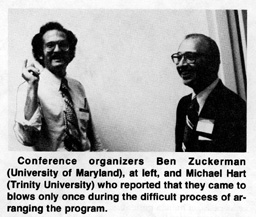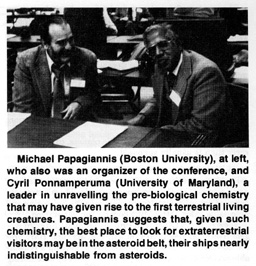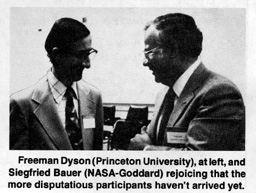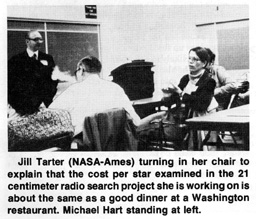'They shall mount up like eagles,' dark-throated assumes,
Cold-sunned, low thunder and gentleness of the authentic Throne.
Vernon Watkins (1906-67)
"Returning to Goleufryn"
 But evidently not to earth, or such was the underlying assumption of the organizers and many of the participants at "Where are They?, A Symposium on the Implications of Our Failure to Observe Extraterrestrials," held at the University of Maryland, November 2 and 3, 1979.
But evidently not to earth, or such was the underlying assumption of the organizers and many of the participants at "Where are They?, A Symposium on the Implications of Our Failure to Observe Extraterrestrials," held at the University of Maryland, November 2 and 3, 1979.
 Less poetically stated, the argument goes that if intelligent life had evolved anywhere else in our galaxy, we would already have found out about it, in the same way the Indians of the Americas found out about Spain and Britain—by being colonized. We haven't been colonized (we think) or even received less unambiguous evidence of 'their' existence; hence there is no intelligent life elsewhere in the galaxy.
Less poetically stated, the argument goes that if intelligent life had evolved anywhere else in our galaxy, we would already have found out about it, in the same way the Indians of the Americas found out about Spain and Britain—by being colonized. We haven't been colonized (we think) or even received less unambiguous evidence of 'their' existence; hence there is no intelligent life elsewhere in the galaxy.
The argument so stated clearly has gaps as wide as the Cumberland, and a large part of the symposium was devoted to the question of whether the current absence of evidence for extraterrestrials really is evidence of their absence. Let's look first at various aspects of that question, and then go on to the "implications of absence", like why isn't there any other life, and what should we do about it?
(1) Have we really failed to observe extraterrestrials?
We have almost certainly not been colonized. All terrestrial living creatures, plants, animals, and one-celled creepy-crawlies, share a common biochemistry and (very nearly) a common genetic code, strongly suggesting that we are all descended from a single origin-of-life. We are not half-native, half-colonist. In addition, as Cyril Ponnamperuma (University of Maryland) pointed out, that common biochemistry is very closely linked to conditions in the primitive earth oceans and atmosphere and to the reactions that could occur there, strongly suggesting that our origin-of-life was strictly homegrown. We are all natives of the earth.
Nor is colonization currently in progress. UFO sightings drift in and out of the popular press, but are apparently not relevant to the question at hand. Robert Shaeffer (a free-lance science writer) discussed some of the most widely publicized sightings. They are systematically explicable in terms of IFO's (Identified Flying Objects, like balloons and satellites) or even NFO's (Non-Flying Objects, like mushroom rings and street lights), with a fair-sized helping, in some cases, of human gullibility and craving for fame.
Less spectacular lines of inquiry haven't told us much so far either. Ben Zuckerman (University of Maryland), reporting on searches for electromagnetic radiation (mostly radio waves, but also laser light and infrared radiation from Dyson spheres) from extraterrestrial civilizations, summarized the situation as "nobody has reported seeing anything." He should know, having been one of the two investigators (along with Pat Palmer, University of Chicago) in one of the more extensive searches for patterned 21 centimeter radiation from nearby, solar-type stars. But he has also remarked on other occasions, that, even if he and Palmer had seen something, they might not have told us about it, not being quite sure of the sociological implications of such an announcement. To put the searches so far carried out in perspective, it should be noted that they would fail by a factor of a million to detect the earth as a radio source from a nearby star and could only have seen anything if another civilization had been beaming a very powerful radio antenna directly at them at exactly the right time.
At this level, we have indeed failed to observe extraterrestrials.
(2) If (intelligent) life is common, should we have seen something?
 Michael Papagiannis (Boston University) suggested that space-travellers would be so used to life in a capsule that they would never consider settling down on planetary surfaces when colonizing a new stellar system. Rather, they would build additional capsules out of local raw materials and continue to live in them. The most likely place for colonists in the solar system might, therefore, be the asteroid belt, and, as a one-kilometer, self-contained space capsule would not look all that different from a one-kilometer diameter asteroid, somebody may already be out there, without our recognizing them.
Michael Papagiannis (Boston University) suggested that space-travellers would be so used to life in a capsule that they would never consider settling down on planetary surfaces when colonizing a new stellar system. Rather, they would build additional capsules out of local raw materials and continue to live in them. The most likely place for colonists in the solar system might, therefore, be the asteroid belt, and, as a one-kilometer, self-contained space capsule would not look all that different from a one-kilometer diameter asteroid, somebody may already be out there, without our recognizing them.
Why should there be colonists at all? The argument has two pieces, one mathematical and one philosophical. The mathematical part was addressed by Eric Jones (Los Alamos) and Michael Hart (Trinity College). If a civilization (feeling either population pressure or the call of adventure) sends out colonists who settle some place, flourish, and in due course send out more colonists, who in turn—and so forth—then it doesn't take very long to use up all the good planets in the galaxy, including, presumably, ours. The result follows largely from the rapid growth of any exponential function and does not depend very much on details of population growth rate, or speed of space ships, or whatever, provided, of course, that space travel is possible.
 Freeman Dyson (Institute for Advanced Study, Princeton) and Cliff Singer (Princeton Physics Laboratory) discussed a range of interstellar propulsion systems. Some of these are considerably more elegant than the Project Orion method of throwing H-bombs out the back of the ship, for instance, accelerating a spaceship by firing a stream of relativistic particles at it from ground and decelerating it by radiating shock waves into the interstellar medium. The important point is not that any one method is obviously the way to go. Rather, the fact that even our rudimentary technology can come up with a couple of possible ways of crossing interstellar distances strongly suggests that there must be other, better ways available to slightly more advanced civilizations. From a mathematical and technological point of view, then, we "ought" to have been colonized.
Freeman Dyson (Institute for Advanced Study, Princeton) and Cliff Singer (Princeton Physics Laboratory) discussed a range of interstellar propulsion systems. Some of these are considerably more elegant than the Project Orion method of throwing H-bombs out the back of the ship, for instance, accelerating a spaceship by firing a stream of relativistic particles at it from ground and decelerating it by radiating shock waves into the interstellar medium. The important point is not that any one method is obviously the way to go. Rather, the fact that even our rudimentary technology can come up with a couple of possible ways of crossing interstellar distances strongly suggests that there must be other, better ways available to slightly more advanced civilizations. From a mathematical and technological point of view, then, we "ought" to have been colonized.
Sebastian von Hoerner (National Radio Astronomy Observatory) and Ronald Bracewell (Stanford University) addressed the philosophical point: why should a civilization send out colonists in the first place?
This sounds like it ought to be important. We can easily imagine (though not so easily achieve!) an alternative. A civilization might keep its population constant and balance its consumption of energy and raw materials with the rate at which these are supplied by its sun and planet (via processes in the earth generating new ores and so on). Another civilization may blow itself to bits early on, still others become fat and lazy or philosophically rather than technologically inclined. But, says von Hoerner, none of this matters. If, as frequently advertized, a million or even a billion civilizations appear over the history of the galaxy, then the urge to colonize, even if very rare indeed, will surely strike one of them. And, concludes Bracewell, since diffusion is likely to be faster than evolution, whoever is out there first can probably preempt the entire galaxy. Perhaps, then, there really are not any other civilizations out there.
(3) Why are we alone?
The standard scenario from the Big Bang to the birth of President Carter runs: hot, dense early universe — lumps in the gas become galaxies — stars form and make heavy elements (those besides hydrogen and helium, which come from the Big Bang) — second-generation stars that can have earth-like planets — chemical evolution — life — biological evolution — intelligence, technology, and Richard Nixon. Foul-ups might occur at any of those stages. Symposium participants worried about many of them.
(a) Stellar and galactic considerations.
Terrestrial life has required a steady energy source, lots of heavy elements, and lots of time for its development. How common are these necessities? Because the abundance of heavy elements has increased only gradually during the life of the galaxy, it is not immediately obvious that many stars exist that can meet all the needs. There might be old stars deficient in heavy elements and young stars generously endowed with them, but few stars with both time and suitable raw materials for life bearing planets. This would be a comforting answer, allowing us to be among the first civilizations on the scene for straightforward astronomical reasons. Unfortunately, it is apparently not the right answer.
I reviewed recent work by Bruce Twarog and Pierre Demarque (Yale University) on ages and compositions of galactic stars. The average age of galactic disc stars is rather greater than that of our sun (6 versus 4.6 billion years); and most of those stars have heavy element abundances like the sun's to within a factor of two or three. Finally, stars of approximately solar mass, and, therefore, solar energy-output make up at least 10 percent of the galaxy. Suitable stars are evidently common.
(b) Planetary considerations.
Earth-like life requires an earth-like environment. Reasonable minimum likeness might include a solid planetary surface with a protective atmosphere and liquid water (meaning temperatures between 0° and 100° celsius at least some of the time) persisting over a billion years or more.
How common are planetary systems? Frankly, we haven't a clue. Pat Harrington (University of Maryland) summarized the observations by saying that, outside the solar system, we have no evidence for any objects less massive than the smallest stars (about 0.06 solar masses or 60 Jupiter masses). Shiv Kumar (University of Virginia) went still further, suggesting that, since as many as 90 percent of all stars may have binary stellar companions, planets might be very rare indeed. This may be correct, although orbit calculations (for example by Robert Harrington, United States Naval Observatory) show that planets can happily circle one or both members of many binary systems for billions of years. Whether or not they can form in binary systems is simply not known.
 Jill Tarter (NASA Ames) predicted that we will be able to detect planets around other stars (if they exist) within ten years or so and, therefore, need not argue about the issue. Unfortunately, even the most optimistic estimates say that we will be able to see only "Jupiters" and not "Earths" through their effects on the motion of their parent stars. Terrestrial planets may orbit half the stars in the galaxy or only one in a million. We cannot tell.
Jill Tarter (NASA Ames) predicted that we will be able to detect planets around other stars (if they exist) within ten years or so and, therefore, need not argue about the issue. Unfortunately, even the most optimistic estimates say that we will be able to see only "Jupiters" and not "Earths" through their effects on the motion of their parent stars. Terrestrial planets may orbit half the stars in the galaxy or only one in a million. We cannot tell.
Even if terrestrial planets are common, livable ones may be rare. The two dangers are run-away ice ages, in which snow and ice reflect so much of the incoming starlight that they never warm up enough to melt again, and run-away greenhouses, in which everything evaporates and forms a blanket around the planet keeping it too warm for water ever to condense and fall again as rain. The planet's life is made still more difficult by the fact that all sun-like stars get gradually brighter over the billions of years they live, and the planet must survive both the cooler early phases without icing up and the warmer late phases without total evaporation.
Papagiannis and Hart have both calculated the fraction of planetary systems in which at least one planet ought to be able to overcome all these hazards for at least a few billion years. Their answers are one-in-a-million and one in 120, respectively. Our one bit of experimental evidence — that the earth has stayed much the same temperature (as judged from the fossil record) while our sun has brightened some 30 percent over the past few billion years — may suggest even a larger fraction than the latter calculation. Clearly more work is needed.
Given a sufficiently high level of technology, we can imagine transforming unpleasant planets into earth-like ones. The process, as discussed by James Oberg (Johnson Space Center) under the heading 'planetary engineering' is somewhat more complex than dumping algae into the atmosphere of Venus and waiting for them to turn the carbon dioxide into oxygen, but it can probably be done. This would affect the number of planet systems available for colonization, but not the number on which life could initially evolve.
The number of planets on which life can begin is presumably increased if biochemistry very different from our own is possible. Gerald Feinberg and Robert Shapiro (Columbia University) considered some of the alternatives. Water, for instance, may not be the only or even best possible solvent (after all, it keeps trying to break up DNA). Liquid ammonia and liquid silicates could expand the livable temperature range to -50° low and a +1000° celsius high. At still lower temperatures (on planets orbiting red dwarf stars?) information might be stored in arrangements of the two forms of solid hydrogen. And these were two of the more conservative ideas!
In any case, planets, or habitable planets, could be much rarer than is usually supposed.
(c) Biological considerations.
Darwinian evolution (self-reproduction with mutations and selection) is a marvelous way to build up extremely complex organisms with enormous capacity for storing and processing information. But how do you get started?
Hubert Yockey (Aberdeen Proving Ground), Edward Argyle (National Research Council, Canada) and Hart presented calculations of the probability of getting a reasonable protein or a reasonable strand of DNA by assembling chains at random from a soup of amino acids or bases, in the lifetime of the earth. Any such calculation yields a very small number, less than one in a billion billion. Either life is extremely rare, not just in the galaxy but in the universe, or it wasn't done that way. Other ways have been discussed in the scientific literature, though none was presented at the conference. Strangely enough, our existence cannot be used to limit the probability of life very much. If we are unique (in a finite universe) or part of a sufficiently rare class (in an infinite universe) then probabilities like one in a billion billion per star or even smaller are not ruled out by our presence. The author's strong prejudice is that the origin of self-reproduction has a much higher probability and is achieved via a straighter path than random assembly of acids and bases. Laboratory biochemical experiments (of the kind often called Urey atmosphere experiments, in which assorted raw materials like methane, formaldehyde, and ammonia are dissolved in water and fed energy for a while) may eventually indicate one or more possible paths. As Ponnamperuma remarked, he's only been working on the problem for twenty years, and nature had several hundred million; be patient!
Thus the probability of life per habitable planet may be anywhere from one down to the smallest number you care to imagine. In an infinite universe, there will be an infinite number of life forms, no matter how small the probability. But they will be very far away.
Richard Gott (Princeton University) addressed the problem of communication under these difficult circumstances, suggesting that the best wavelength for broadcast and reception may be 5 to 6 millimeters, near the peak of the microwave background radiation, rather than the 21 centimeter wavelength of hydrogen. In any case, dialogue would not be possible among civilizations in different galaxies, as the round-trip message time runs to millions or billions of years.
Finally, of course, it is possible that life, or even intelligent life, may be common, but technology rare. One feels vaguely that the existence of whales and dolphins — intelligent but non-technological species on earth — must somehow be relevant, but it is far from obvious how to use them to estimate the probability of technology occurring among extraterrestrial life forms! Gerrit Verschuur (Human/Dolphin Foundation), who was to have discussed some of these issues, was unable to attend the symposium.
Obviously, our failure to observe extraterrestrials is fully accounted for if life, intelligence or technology are sufficiently rare.
(4) What should we do about it all?
Many of the symposium participants concluded that life (at least intelligent life) is genuinely rare in our galaxy. This is partially a selection effect.
Faithful readers of this magazine will have missed among the named participants many of the best-known advocates of SETI. Still, the non-life (or anti-life) point of view clearly has some justification and is entitled to have its consequences explored. As usual, there are two pieces; deciding whether it is right, and deciding what to do about it.
(a) The future of SETI.
Perhaps the most "anti" statement of all came from Kumar, who, in both printed abstract and talk, "continues to be opposed to expensive programs for search for 'intelligent' life around other stars." His definition of 'expensive' includes the searches now in progress or recently completed. This prompted the author to an envelope-back calculation. The cost-per-star, for instance, of the Palmer-Zuckerman 21 centimeter search or the one now in progress at NASA Ames (described by Tarter) is $10 to $100. At that rate, the cost of assembling the symposium participants, taking them away from their regular jobs for two days, and so forth, would have paid for searching several hundred stars. Perhaps we should all have stayed home? On any less extreme view, clearly the only thing to do is keep looking — if we don't look, we are guaranteed not to find anything! — and keep thinking about the problems between the Big Bang and interstellar travel, some of which have been introduced above.
(b) The future of man in space.
Pogo once looked up at the sky and said, "Either there is somebody else out there, or there isn't. Either way, it's a sobering thought." It is indeed. If it turns out that human life is the most advanced form in the galaxy, then many of us would perceive it as even more valuable than we had previously thought and want to act accordingly. And if we are indeed alone, then we have the opportunity (the responsibility?) to, in Bracewell's words, preempt the galaxy and rebuild it as we see fit. Singer suggests that (if we don't blow ourselves up first) interstellar travel is possible in a hundred years, likely in a thousand, and unavoidable in ten thousand. But he also said that the most important thing is not when we get into space but the quality of life we send there. That is perhaps the right note to end on.
|
Symposium Gleanings
Is the current absence of evidence of extraterrestrials really evidence of their absence?
We are all natives of the earth.
The most likely place for colonists In the solar system might be in the asteroid belt.
Since diffusion is likely faster than evolution. whoever is out there first can probably preempt the entire galaxy.
Even if terrestrial planets are common, livable ones may be rare.
In an infinite universe there will be an infinite number of life forms, no matter how small the probability, but they will be very far away.
It is possible that life, or even intelligent life, may be common but technology rare.
Our failure to observe extraterrestrials is fully accounted for if life, intelligence or
technology are sufficiently rare.
If we don't look, we are guaranteed not to find anything.
Either there is somebody else out there or there isn't; either way it's a sobering thought. It is indeed.
If it turns out that human life is the :most advanced form in the galaxy, then many of us would perceive it as even more valuable than we had previously thought and want to act accordingly.
If we don't blow ourselves up first, interstellar travel may be possible in a hundred years, likely in a thousand and unavoidable in ten thousand.
But the most important thing is not when we get into space but the quality of life we send there.
|

A biographical sketch of Virginia Trimble appeared in the Winter 1980 issue of COSMIC SEARCH (vol. 2, no. 1) in connection with her article "It's a Nice Planet to Visit But I Wouldn't Want to Live There".
[Although the biographical sketch was not reproduced with this article in the magazine, I have reproduced it below from a previous article. — Webpage Editor]
 Virginia Trimble has published research papers on white dwarf stars, pulsars, black holes, x-ray stars and supernovas
and has written many articles, such as "Cosmology: Man's Place in the Universe", "Are Galaxies Here to Stay?" and "The Origin and Abundances of Chemical Elements".
Virginia Trimble has published research papers on white dwarf stars, pulsars, black holes, x-ray stars and supernovas
and has written many articles, such as "Cosmology: Man's Place in the Universe", "Are Galaxies Here to Stay?" and "The Origin and Abundances of Chemical Elements".
Born in Los Angeles, California, in 1943, Dr. Trimble received her Bachelor's degree (Phi Beta Kappa) from the University of California at Los Angeles in 1964 and her Master of Science degree in 1965 and Doctor of Philosophy degree in 1968, both from the California Institute of Technology. She also received a Master's degree from the University of Cambridge, England, and held a post-doctoral position there for two years in the Institute of Theoretical Astronomy.
She has been an Alfred P. Sloan Foundation Research Fellow (1972-76), a Phillips Lecturer (1973), a Sigma Xi National Lecturer (1974-77), the Maryland Academy of Sciences' Outstanding Young Scientist for 1976, the Luce Cosmology Lecturer at Mount Holyoke College (1978) and Phi Beta Kappa Visiting Scholar (1979-80).
Virginia Trimble shares appointments with her husband, Joseph Weber, the gravity wave pioneer, at the University of California, Irvine (where she has tenure) and the University of Maryland (where he has tenure).
Dr. Trimble is in frequent demand at professional meetings and conferences where she has delivered invited review papers on galactic structure, gravitational radiation and other subjects and at colleges and laboratories where she has given many popular talks on a wide variety of astronomical topics.
[The following omission was noted in Issue 7 (Summer 1980) on page 14. It is reproduced here.
Omission
In connection with Virginia Trimble's Symposium Report in the Spring 1980 issue of COSMIC SEARCH, we inadvertently omitted a note to the effect that the photographs accompanying the article were by the author.
![[NAAPO Logo]](../../Images/NAAPOsm.jpg)
![[NAAPO Logo]](../../Images/NAAPOsm.jpg)